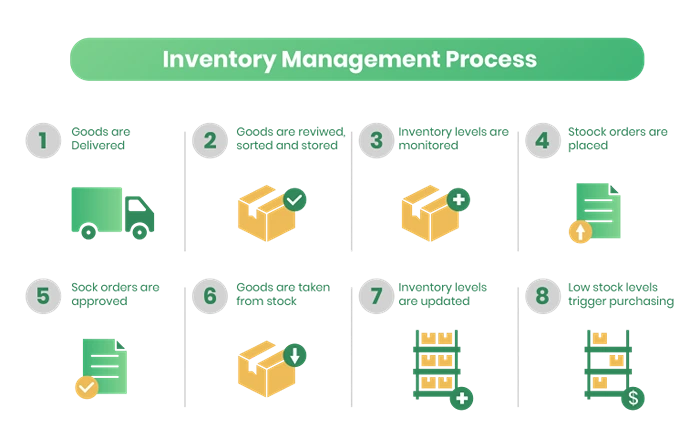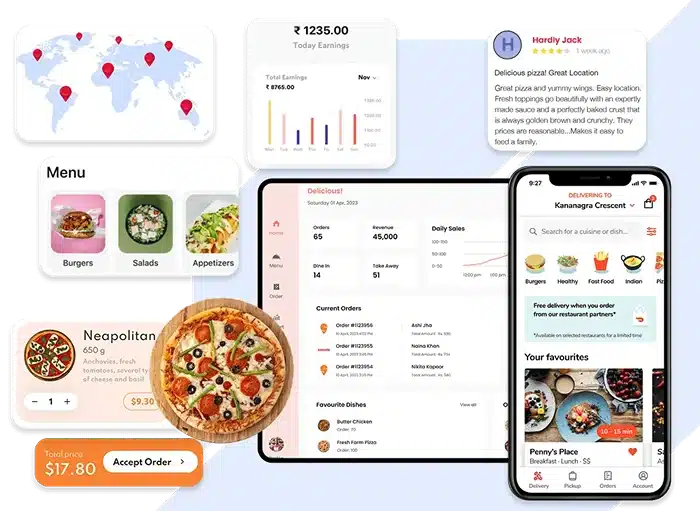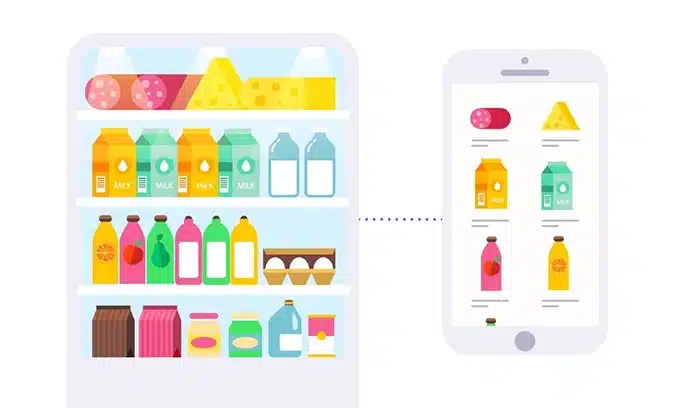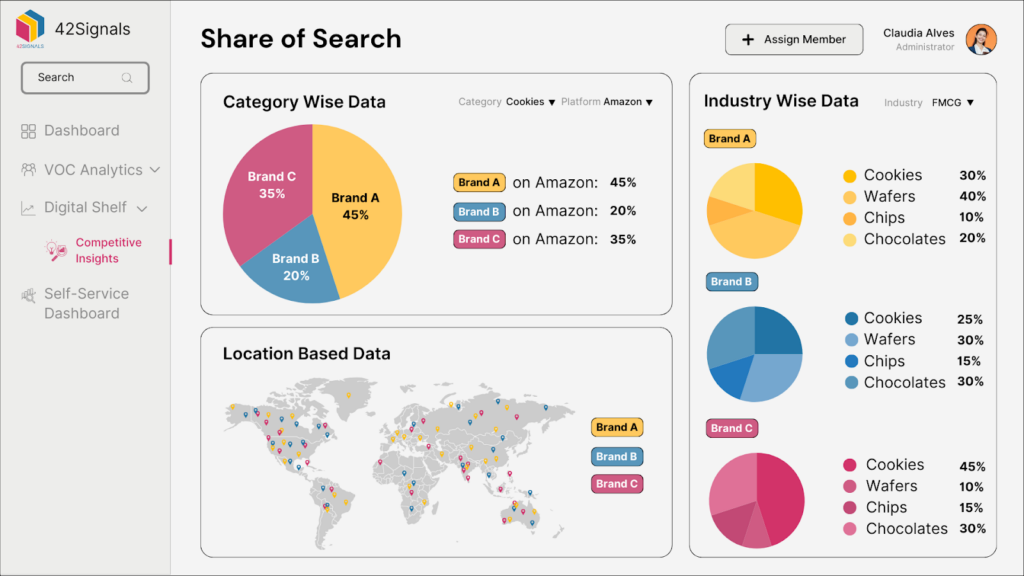**TL;DR**
Products vanish from shelves more often than most F&B teams realize—sometimes they’re out of stock, sometimes they’re just in the wrong place, and sometimes they’re listed online but marked “unavailable” for no good reason. That’s where SKU tracking and real-time shelf data come in.This guide looks at how food and beverage brands are using SKU-level insights to fix inventory gaps, improve retail execution, and make sure their products are actually visible when and where people are shopping. It also dives into how web scraping services help collect shelf and listing data across both physical stores and eCommerce platforms, giving teams the chance to react faster, plan smarter, and avoid those silent losses that don’t show up until it’s too late.
If you’re responsible for making sure your products stay in stock, show up correctly online, and keep pace with competitors, this article’s for you.
Why Retail Shelf Visibility Matters for Food and Beverage Brands

Image Source: themindsite
If your product isn’t on the shelf, it might as well not exist.
Let’s say someone walks into a supermarket or browses their favorite grocery app. They’re ready to buy. Maybe they’ve seen your ad. Maybe they’ve bought it before. But they don’t see it on the shelf. No stock. No listing. They’ll shrug and pick something else.
It happens. Products disappear, not because they’re gone forever, but because something small slipped. One location didn’t get the shipment. Another didn’t restock fast enough. Sometimes, a product is even there, just misplaced or shown as “out of stock” online when it’s sitting in the warehouse.
And here’s the cost: not only do you lose the sale, you lose brand trust.
That’s why SKU tracking matters so much today. F&B teams aren’t just tracking sales; they’re keeping tabs on availability at the SKU level, across retail locations and websites. With help from digital shelf analytics and web scraping services, they’re flagging problems before shoppers notice them. It’s not just inventory management—it’s brand defense.
In this guide, we’ll break down how it all works and how some of the most competitive food and beverage brands are using this data to stay visible, stay stocked, and stay ahead.
What Is SKU Tracking and Why Is It Vital for Product Availability
Let’s break it down. SKU tracking is exactly what it sounds like: keeping track of individual products—by their stock keeping unit—across stores, warehouses, and platforms. For F&B brands, that means everything from a 500ml cola bottle to a six-pack of yogurt has its own unique identifier. And each of those needs to be monitored.
It’s not just about knowing how many units you’ve shipped. It’s about knowing where they are now. Are they on shelves? In stock? Properly displayed? Missing altogether? Tracking that data in real time is where things get interesting.
The reason SKU tracking has become so important is because of how messy retail gets. Products get stocked late. They get shelved in the wrong place. Or worse, they’re shown online but marked “unavailable” for days. That kind of gap doesn’t just hurt sales—it confuses loyal customers and makes the brand look unreliable.
By focusing on the SKU level, brands get clarity. Not just an overview, but real, store-by-store and item-by-item visibility. It’s not a spreadsheet anymore. It’s a live feed of what’s really happening out there, on the ground.
Done right, it helps answer questions like:
- Why did sales dip in that region last week?
- Which stores aren’t following stocking guidelines?
- Are our top sellers actually on the shelf?
In a space as competitive as food and beverage, you can’t afford to guess. SKU tracking gives you answers—fast.
Inventory Management and SKU Data: The Backbone of Shelf Availability
Inventory issues don’t start in the warehouse. They show up where customers are—at the shelf.
That’s why having access to SKU-level data matters so much. It allows brands to track what’s happening with each product, not just in bulk, but item by item. It’s the difference between guessing and knowing.
Let’s say a line of flavored drinks has been underperforming in one region. Sales reports alone won’t tell you why. But SKU data? It might show that only two out of five flavors are making it to the shelves. Or that stock is arriving late and sitting in the back room instead of going out front.
This kind of inventory tracking isn’t about spreadsheets. It’s about finding out—quickly—where the chain breaks down. And once you know that, you can act.
Brands using SKU tracking get a clearer picture of what’s really going on at the retail level. Some teams now catch problems early, like when an item’s been stocked in the wrong aisle or isn’t showing up at all. It’s the kind of thing they used to hear about from a store manager or customer complaint. Now? Real-time data points them there first.
In other words, it helps them show up when it matters most.
Preventing Stockouts: How F&B Brands Use SKU Tracking to Stay Ahead
Stockouts aren’t just missed sales. They’re lost opportunities—and sometimes lost customers.

Image Source: Advotics
When “Out of Stock” Means Out of Mind
It doesn’t take much for a loyal shopper to switch brands. If your drink, snack, or frozen item isn’t on the shelf, they’ll grab the next best thing. They may not come back.
For food and beverage brands, this happens more than many realize. One location runs out of stock over the weekend. Another store forgets to reorder. Online listings show “unavailable” because the backend system wasn’t updated. Meanwhile, the customer just sees a missing product and moves on.
How SKU-Level Tracking Prevents the Guesswork
Here’s where SKU tracking becomes a game-changer. Instead of waiting for a sales report to highlight a dip, teams can monitor what’s happening in real time. Say one of your products disappears from a few locations midweek. In the past, that might not show up until someone flagged it, or until the numbers dipped weeks later. Now, you can spot it almost as it happens.
This is especially helpful when you’re dealing with multiple SKUs under the same product line. Say you have six variants of a cereal. If one flavor is constantly out of stock, SKU-level data will catch that fast.
You can then act quickly: reroute stock, check with the distributor, or even trigger a digital alert to store staff.
Inventory Management That Works
Old-school inventory management relied heavily on back-office systems and quarterly audits. But those don’t help when you’re bleeding sales day by day.
Real-time inventory tracking, powered by SKU data, offers a much more accurate picture. It shows not just how many units were sold, but what’s actually available on the shelf—or not.
And that’s where brands find their edge. They’re no longer waiting to react. They’re staying ahead.
How Web Scraping Services Power Real-Time Shelf and SKU Insights

Image Source: foodspark.io
Staying visible on retail shelves—physical or digital—means knowing what’s really happening out there. Not what you hope is happening. Not what last quarter’s data shows. What’s happening now?
That’s where web scraping services step in.
Data Collections for Retail Monitoring
At a basic level, web scraping is the process of automatically collecting information from websites. But for food and beverage brands, it’s much more than that. It’s a way to get fresh data on how products are listed, priced, and stocked across dozens or hundreds of retailer websites.
Using scraping tools, brands can track SKUs across online stores and marketplaces. Is the product listed correctly? Is the description accurate? Is the item showing as “in stock” when it’s not? These are things that impact digital shelf performance and sales.
More importantly, the same data can also flag retail execution issues, like pricing mismatches, missing images, or outdated promotions.
Automated Checks
Relying on field reps or one-off audits might have worked a few years ago. But with so many SKUs, stores, and platforms involved, it’s just not scalable anymore.
By using web scraping services, F&B teams can monitor everything at once—from flagship SKUs to smaller seasonal items. The data comes in automatically, day after day. You don’t have to chase it.
And it’s not just about online stores. Many brands are now combining scraped web data with in-store tracking tools to get a full picture of their inventory management and shelf presence.
The Real-Time Advantage
The big win here is speed. Traditional reports come too late. Scraped data comes fast, sometimes within hours. That gives brand and supply chain teams the edge they need to fix problems before they cost sales.
A product disappearing from a store’s website? You’ll know. A mismatch in product info? You’ll catch it. That’s the power of using SKU tracking with real-time web data.
What Is the Digital Shelf?

Unlike physical shelves, the digital shelf is made up of search results, product pages, category listings, and filters across eCommerce platforms. It’s where your SKU either shows up—or disappears.
And visibility on that shelf is algorithm-driven. Retailers decide what gets seen based on factors like availability, pricing, and how complete your product content is.
If your data is outdated or inconsistent, your product could drop off entirely.
Digital Shelf Analytics: Monitoring Visibility and Positioning Online
More people shop with their phones now than ever. They search, scroll, compare—and if your product isn’t easy to find, that’s pretty much the end of the story.
This isn’t just about in-store displays anymore. The online shelf is very real. It’s not flashy or physical, but it decides whether your product gets seen or skipped.
Think of what happens when a snack or drink doesn’t show up in search results, or looks out of stock, even when it’s not. That moment costs you a sale.
This is where digital shelf analytics come in. They help brands see how their SKUs are showing up across websites and grocery apps. Not in theory—in real time.
Online Product Availability Is Easy to Miss
You might assume that once a product is listed online, it stays there and stays available. But that’s rarely the case.
One SKU might be marked “in stock” in the system but show “out of stock” to customers. Another might be missing images or be tagged under the wrong category. These aren’t just tech issues; they affect conversions.
Because digital shelves update constantly, these errors often go unnoticed unless you’re actively monitoring them.
SKU Tracking in a Digital Context
When you apply SKU tracking to the digital shelf, it gives you a much clearer view of performance. Instead of treating online listings as static pages, you treat them as live retail touchpoints, and each SKU becomes its own signal.
Are all your variants appearing across key retailers? Are seasonal items actually live when the campaign goes out? Are prices consistent across regions?
SKU-level data answers those questions. It doesn’t just show what’s selling—it shows where your presence is slipping.
How Web Scraping Services Help Monitor the Digital Shelf
This is where web scraping services start to make a real difference. Instead of waiting on a sales report or someone in the field to raise a flag, brands can see what’s happening online—fast.
These tools pull product data straight from retailer sites. Not once a week. Sometimes multiple times a day. That includes your SKU’s price, image, title, stock status—basically, how it appears to a shopper.
If something’s wrong—maybe a listing disappears, or a banner promo doesn’t go live—you don’t have to guess. The data catches it. You get a heads-up, and more importantly, a chance to fix it before someone else notices it first.
Improving Digital Execution with Real-Time Insights
Digital shelf analytics also supports better coordination across teams. Marketing can align campaigns with what’s actually live. Retail execution teams can spot listing problems faster. And the supply chain can respond to demand signals based on real-time availability.
It’s not only about checking if a product shows up. What teams are really doing now is shaping how shoppers interact with their brand online, whether that’s through a clean product page or just having the right items in stock.
And when does the system actually work? It keeps things running smoother—fewer gaps in inventory, better promo timing, and less scrambling when something goes off track.
Staying Competitive on Every Shelf, Physical or Digital
You’re competing not just with rival brands, but with visibility itself. On crowded retailer platforms, a missing product tile or a broken listing is all it takes to lose a sale.
With the right combination of SKU tracking, digital shelf analytics, and web scraping services, F&B brands can stay visible, consistent, and ready—everywhere their customers are looking.
Turning SKU Data into Action: Improving Retail Execution Strategies
Data means nothing if it just sits in a dashboard. What sets successful F&B brands apart is how they turn SKU-level insights into action.
Sometimes, that action is as simple as alerting a distributor about a low-stock issue. Other times, it’s a full reset of a retail strategy based on underperformance across regions. But the key is this: decisions aren’t made in the dark anymore.
From Visibility to Execution
Let’s say you’re tracking 100+ SKUs across a chain of national retailers. Sales look fine at a glance, but your SKU tracking system notices that three top-selling variants are consistently missing from the shelves in suburban stores.
Now, that’s not just a product issue. It’s a retail execution problem.
You dig into the SKU data and realize those locations aren’t following shelf placement guidelines. Promotions are running, but without the matching inventory. That’s a disconnect between marketing and store execution—and it’s costing real money.
Adjusting Promotions in Real Time
With access to accurate, store-level data, brands can make smarter adjustments mid-campaign. If a new product isn’t moving, you can check whether it’s even reaching the shelf. If promo pricing isn’t showing up online, you can push a fix before the weekend hits.
Web scraping services help here too. You’re not just tracking in-store performance—you’re monitoring online listings, placements, and pricing across retailers. It all feeds into one ecosystem.
Cross-Team Collaboration Gets Easier
SKU tracking doesn’t just serve supply chain teams. When you make real-time inventory tracking accessible to sales, marketing, and operations, execution improves across the board.
Marketing stops pushing products that aren’t on shelves. Sales teams stop guessing which stores to prioritize. And operations? They finally get ahead of issues instead of reacting late.
Spot Issues. Act Fast. Repeat.
This isn’t about perfection—it’s about being responsive.
A store goes out of stock? Flag it. A product gets mislisted online? Fix it. A new SKU isn’t turning on shelves? Re-evaluate your rollout plan.
SKU data gives you visibility. Action is what you do with it.
Competitive Intelligence with SKU Tracking and Shelf Monitoring

Sometimes the biggest risk to your shelf space isn’t your own supply chain—it’s what your competitors are doing right under your nose.
In crowded categories like snacks, drinks, and ready-to-eat items, shelf space is a battleground. And most of the time, brands have no idea they’re being edged out until it’s too late.
Know Who You’re Competing With Today, Not Last Month
Let’s say you’re tracking your SKUs and notice sales have dipped at a specific regional retailer. Your products are in stock, the promotions are running, and everything looks fine on your end.
But then you take a closer look at the shelf data—your biggest competitor just rolled out a price cut and a new in-store display at that same retailer. They didn’t announce it, and it’s not showing up in your reports. You only spotted it because your monitoring tools caught the change.
That’s the kind of real-time shelf intelligence that makes a difference.
SKU Tracking Isn’t Just About You
When used well, SKU tracking doesn’t just tell you about your own products. It also shows what’s happening with every brand around you.
Which competitor is gaining shelf share this quarter? Who’s slipping in availability? Are new entrants getting featured more often? Is a private label brand creeping up in the same category?
You don’t need to guess. With the right data, you can see these shifts as they happen, not weeks later when the sales are gone.
Web Scraping Services Add the Missing Layer
Sure, it helps to see what’s happening in stores, but that’s just part of the picture. Online, things move even faster. Many brands now use web scraping services to keep an eye on how their competitors show up across different retail sites. They’re not just checking stock either—they’re watching for price drops, sudden promotions, even changes in how products are described.
If a rival brand drops prices across five sites overnight, you’ll know. If their product starts ranking higher in search results due to better descriptions or updated images, you’ll see that too.
That kind of visibility lets you respond with speed and strategy.
Choosing the Right Web Scraping Partner for Digital & Physical Shelf Analytics
Not all data partners are built the same. And when your business depends on staying visible, online and in-store, you can’t afford to pick one that’s just okay.
Tracking SKU data at scale takes more than a simple scraping tool. You need a system that’s flexible, fast, and actually understands the retail space.
Look Beyond the Dashboard
Some providers will show you nice graphs and call it a day. But that’s not enough when your team needs raw, structured data, broken down by SKU, by store, by day. Whether it’s inventory levels, shelf placement, or product visibility online, your team needs more than pretty charts. They need answers.
A good partner will not only gather that data but deliver it in a way that fits your systems. CSV, API, cloud—you name it.
Customization Matters More Than You Think
The best web scraping services don’t force you into a rigid platform. They let you define what you want to track: specific SKUs, regions, retail chains, competitors, or even timeframes.
Let’s say your team needs weekly updates on 200 products across three major online retailers. Next quarter, maybe that doubles. A serious data partner scales with you. You shouldn’t have to start over every time your tracking needs change.
Accuracy Is Non-Negotiable
Bad data is worse than no data. If you’re making decisions based on product availability or shelf presence, it has to be right.
A quality provider will have checks in place—automated and manual—to make sure the SKU data you’re seeing reflects what’s really happening.
It’s also worth asking how often they refresh data. In retail, “real-time” shouldn’t mean yesterday.
Why PromptCloud Fits the Bill
PromptCloud works with large-scale F&B brands to provide custom web scraping services built for real-world retail problems. We don’t sell off-the-shelf dashboards—we deliver high-quality, tailored data feeds that plug right into your workflows.
Whether you’re tracking inventory, shelf presence, competitor activity, or digital listings, we’ve helped brands like yours use SKU tracking to make better, faster decisions.
Win the Shelf with SKU Tracking and Real-Time Analytics
Most F&B teams don’t lose shelf space because they stopped trying. They lost it because they couldn’t see what was going wrong soon enough.
One week, a top-selling SKU is out of stock in a few stores. Next, it’s missing from search results on a major grocery app. By the time someone notices, it’s too late. Customers have already picked something else.
This is where real-time visibility changes things.
With SKU tracking and well-structured inventory data, brands don’t have to guess where problems are. They know. They’re able to act before gaps become trends. And with the help of web scraping services, they can keep an eye on how products look and perform across dozens of retail sites without doing it manually.
None of this is theoretical anymore. The tools exist. The challenge now is deciding to use them, not just to report, but to respond. Because in this market, the brands that move fast are the ones that stay visible.
For customised F&B data, reach out to us at sales@promptcloud.com today!
FAQs
1. What exactly is SKU tracking and why does it matter for F&B brands?
Think of each SKU as a single product variation—size, flavor, pack type, all that. Tracking at that level means you’re not just looking at overall stock numbers. You’re watching which exact items are showing up where. For F&B, that’s critical. A store might have chocolate bars, sure—but if the 12-pack your team just promoted isn’t on the shelf, then the promotion’s basically invisible. SKU tracking helps you catch that stuff.
2. How does web scraping help with shelf visibility?
Instead of having someone check every retailer site manually (which no one has time for), scraping pulls that data for you—automatically. Say you want to see if your iced tea bottles are showing up on five grocery websites, or if your competitor just dropped their prices. You set it up once, and the data keeps coming in. It’s not fancy for the sake of being fancy—it just saves hours and catches issues earlier.
3. What kind of problems can SKU-level data help fix?
Plenty. It helps when a product’s out of stock in only certain stores, or when something’s available but showing the wrong photo or price online. Sometimes it’s more subtle—like when one flavor always gets restocked late. You don’t always spot those trends from top-level reports, but SKU-level data makes them a lot easier to catch.
4. Isn’t inventory management enough? Why track at the SKU level?
In theory, your inventory system should tell you everything. In reality? It tells you what was shipped or received—not what’s actually out there in front of the shopper. SKU tracking picks up the gaps between the warehouse and the shelf. That’s where most visibility problems live.
5. What should I look for in a web scraping services partner?
Make sure they don’t give you a cookie-cutter solution. Your team’s going to have its own weird mix of SKUs, retailers, regions—so flexibility matters. Also, check how they deliver the data. If it takes five steps just to open a report, it’s going to sit in someone’s inbox. And yeah—accuracy. You can’t make shelf decisions based on the wrong data. That’s just trading one problem for another.



















